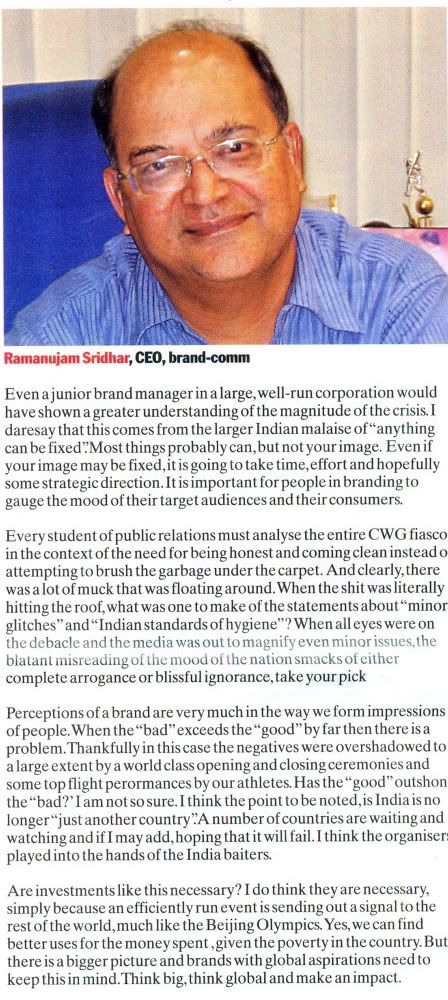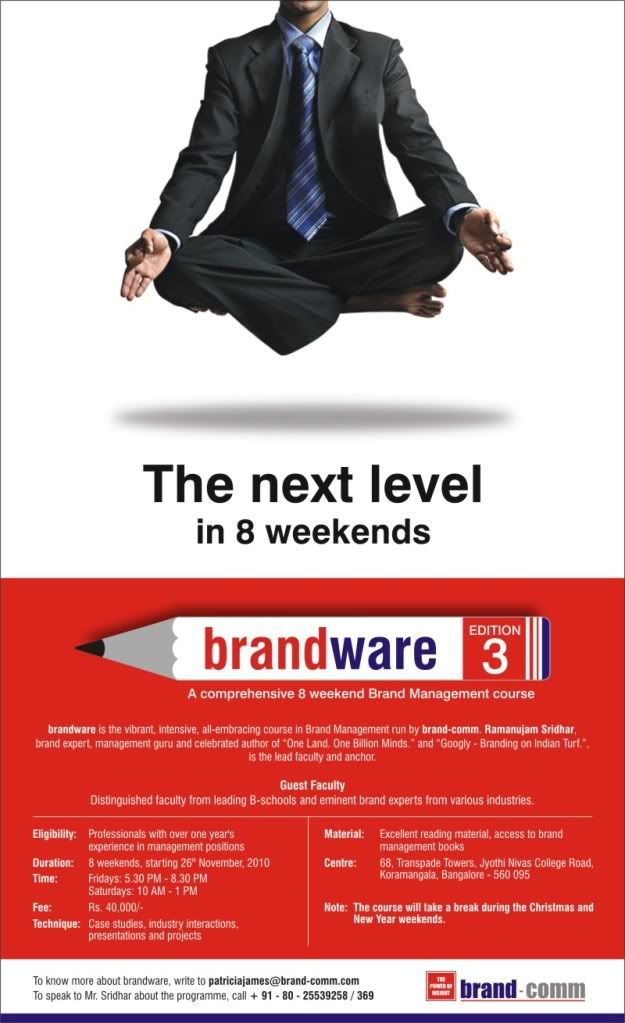 They made for much hype, agitation and excitement - the Y2K bug, the dotcom bust, the cell phone, big-buck brand campaigns, middling service notwithstanding ….
They made for much hype, agitation and excitement - the Y2K bug, the dotcom bust, the cell phone, big-buck brand campaigns, middling service notwithstanding ….Writing a year-end column is challenging enough but to review the decade is a bit like landing up at the Centurion on a damp, murky day straight from the airport and finding Dale Steyn thundering in and suddenly realising that you have walked in to bat without your protector! On the lighter side I was trying to recall just what are the changes that have happened in my own life over the last decade and came up with a sensational discovery.
Ten years ago I used to painstakingly write my column on ruled sheets of paper and my secretary (who is now in Australia perhaps supporting the rejuvenated Aussies) would dutifully key it in. (I used to have a decent handwriting thanks to the plethora of loving and frequent impositions that my old school, Don Bosco Egmore in Chennai, so lavishly bestowed on me.) But today, as I key in my fortnightly 1,500 words religiously on my Apple laptop, my handwriting has gone for a toss. Of course, we could argue endlessly about whether my ability to write columns has improved! But let's move to more dramatic things - the economy, the consumer, brands, communication and life in India over the last decade. What has happened and what seems likely to happen in the near future? Let's take a look at the past before we venture our opinion on the future.
Y2K to Wikileaks
Do you remember the turn of the last century and the excitement, the dread around the Y2k bug and its impact on the software business at least? Well, things have blown over and the winds of change have blown in - something more sensational - Wikileaks. God, has the media gone to town or what, with every politician and statesman making more off-the-cuff remarks than Tendulkar's numerous centuries. The decade witnessed the dotcom boom and consequent bust. I remember (painfully) that our company that was called brand.comm became brand-comm as we went away to lick our wounds after putting all our eggs in the dotcom basket. Speak of the power of brand recall, many of our clients and well-wishers still refer to us as brand.comm. But the World Wide Web has taken over and digital is the medium to be in and everybody and his brother-in-law claims to have a digital strategy.
Of course, while many are denying that digital will actually take over the Indian markets, there is no denying its potential or criticality and the smarter, savvier brands are those that are showing the way rather than following the leaders. In a sense, India had been a follower of Madison Avenue earlier and is following in this medium too, as connectivity and security issues continue to dog us. But make no mistake, India is poised to fly and is just waiting to take off despite the blocks. But India has to discover its own new model which might be a marrying of offline with online. Consider a marriage site such as bharatmatrimony.com which has offline centres where horoscopes are printed and given to anxious and yet technologically challenged parents. India has traversed the mobile space with greater speed than several others and soon there might be a union of the two to move ahead. The future will have to do with harnessing the power of the mobile.
Roti, kapda aur mobile
No analysis of the last decade in India would be complete without the telecom and mobile revolution that has swept through the country. Even small villages in India discovered the pleasures of being in touch with their relatives in far-flung places thanks to the STD booths that littered the length and breadth of this country. Today, thanks to technological innovations it is possible for someone living in the villages to do a video call with family members he has left behind in his quest for employment and livelihood.
But I am getting ahead of myself and missing the mobile services revolutions. This is something India and Indians can be justifiably proud of. Today the mobile population is close to 800 million with 16 million phones being added every month. Mobile phones from China and Taiwan have flooded the market and new brands such as Micromax are giving the leader Nokia a run for its money. Mobile service operators continue to advertise heavily - and often produced outstanding advertising. Brands that readily come to mind are Idea Cellular with their “What an idea, Sirjee!” and the Vodafone campaigns featuring the now famous pug dog and the Zoozoos. There is no doubt, in my mind at least, that mobile services advertising has overtaken the colas in creativity.
The sad reality, though, is that advertising agencies continue to create ads that are independent of the quality of the service. Of course, this strategy is not unique and continues to apply to banks as well. But to return to the mobile services business, while it has continued to be driven by schemes, price offers and tremendous advertising expenditure, there has been a game-changing strategy too. I speak of the Tata Docomo strategy of per second billing which the competitors too had to reluctantly follow, to the delight of the consumer who continues to speak as rapidly and as needlessly as some of our TV commentators.
The retail revolution
It is difficult to discuss the last decade in India without the growth of organised retail as players such as the Future Group.
Trent and Reliance followed the Shoppers Stops and the LifeStyles of the world and went into the smaller towns and realised there was a completely service-starved consumer waiting for them there. Yes, the value format was here to stay and the consumer in the smaller town was growing in confidence and affluence. On October 15, 2010 no less than 150 Mercedes Benzes were sold on a single day at Aurangabad!
After that interesting titbit, let's return to organised retail which, though it may get media attention and interest, accounts for less than 3.5 per cent of the total trade. Not a figure to be sneezed at but nothing to set the Ganga on fire either! Yet, the decade has witnessed the emergence of private labels and the beginning of the tension between brand marketers and large formats, which are pushing brands to be on sale constantly. Brand values are being diluted by each and every sale and hardly anyone visits the company showroom as they find the well-lit, air-conditioned factory outlets a far cry from the factory outlets of yesteryear where you had to check your merchandise and could not exchange it even if it was defective. How times have changed and with it, consumer preferences!
Summing up
The consumers are changing, becoming more affluent and more demanding. They are used to quality, such as the new airports. Service and consumer engagement will be the key. How good is your service offering? Price is important as Big Bazaar has demonstrated. But how well are you positioned? The Nano is struggling as it is seen as a “cheap car”.
Agencies, in their quest to talk about things like “consumer connect”, are forgetting the importance and value of the big idea, fragmenting their resources and trying to achieve too much with too little.
The decade was easily the decade of crises – whether it was the financial crisis or scam after scam that India unearthed. The media too, which was busy playing judge and jury, suddenly found itself in the dock. Crisis management was key and few of the companies seem to have mastered the fine art of crisis management. And the next decade will see more of this. After all, we live in Kalyug, don't we!
Companies that pay lip service to social media and are experimenting with it without their hearts in it or getting their hands dirty are going to be hit, and soon. Companies that harness the mobile phone's capability will thrive.
Agencies continue to bemoan the lack of talent and yet steadfastly refuse to train their personnel. First we pay peanuts and then refuse to train the monkeys that we have brought into the industry, lest they be poached. Why wouldn't clients be frustrated?
Clients, even as they understand and appreciate the need for good creative, continued to haggle on prices even as they complained about the quality of service.
Brands changed their identities, often because they seemed bereft of other ideas to rejuvenate themselves. When will brand owners realise it is more important to get the essence of the brand right rather than merely tinkering with cosmetic things?
And finally, longevity will be key. Brands that endure will have clarity and consistency. In 1999 I was in England for the best World Cup to date and Sachin Ramesh Tendulkar had to rush back to India for his father's funeral. He came back to thrash bowlers all over the park and dedicate his efforts to his deceased father. Now he has scored his 50th test century and dedicated that too to his father. So that's one factor that has been consistent through the turbulent decade.
Consistency and longevity will continue to be key in the next decade as well. Here is wishing you a great year first and a wonderful decade later!
Ramanujam Sridhar, CEO, brand – comm.
Read my blog @ http://www.brand-comm.com/blog.html
Facebook: facebook.com/RamanujamSridhar
Twitter: twitter.com/RamanujamSri














